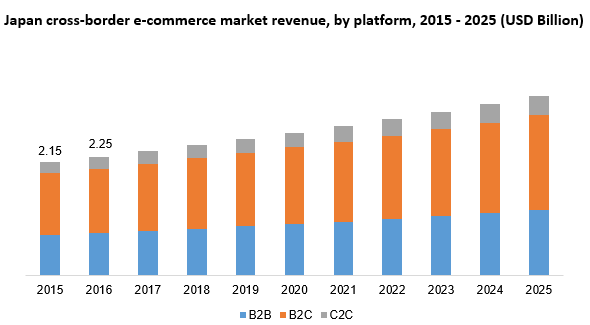
Japan Cross-Border E-Commerce Market Size And Forecast, By Platform (B2B, B2C, C2C), By Application (Food & Beverage, Personal Care, Furniture & Appliances, Toys, Hobby & DIY, Electronics & Media, Fashion), And Trend Analysis, 2019 - 2025
- Published: February, 2019
- Format: Electronic (PDF)
- Number of pages: 65
- Industry: Next Generation Technologies
Industry Insights
Japan cross-border e-commerce market size was USD 2.36 billion in 2017 and is projected to grow at a CAGR of 4.7% from 2017 to 2025. The country has a high proportion of the urban population and internet penetration rate of around 80.0%, with over 70.0% of the population having purchased products online, are among some of the factors supporting the growth of cross-border e-commerce.
The allure of foreign brands, especially British, adds to the growth of the industry. However, U.S. and China are the key destinations for Japanese consumers for cross-border e-commerce. With a fast speed secured connection and the mobile phone penetration rate of 102%, around 10.0% online consumers shop from overseas e-retailers in the country.

Over the past few years, cross-border e-commerce has become one of the key selling mediums which has resulted in making trade movement in terms of exports and imports much easier. Furthermore, the introduction of advanced smartphone variants along with the expansion of fast speed secured connections has increased the visibility of cross-border e-commerce.
Cross-border e-commerce portals facilitate interaction with the customer service staff who can clear customer queries or doubts as they can translate the web page after learning about the client requirements, as Japanese customers prefer shopping portals which have instructions in their native language.
This also helps in building effective customer relationship which is similar to the closeness the customers share with sellers located in their domestic vicinity. Also, the improvement of logistics infrastructure in Asian countries such as China is expected to ensure effective product shipping to the country. Consumers also benefit from buying tax-exempt goods from cross-border online platforms.
Japan is one of the leading global e-commerce markets with companies selling products from various domains including personal care, consumer electronics, and apparel. Japanese consumers usually patronize the categories that have optimal pricing and they associate more with. Furniture & appliances category commanded more than 25.0% of the market share in 2017. One of the key facilitators is the infrastructure and advanced logistics systems, which ensures efficient movement of merchandise from the source to the consumers in a time-efficient manner.
Segmentation by Platform
• B2B
• B2C
• C2C
B2C (Business-to-Consumer) platform held the largest share, accounting for more than 50.0% of the market in 2017. This growth is attributed to the continuous progress in the digitization of transactions and the presence of a number of e-commerce platforms offering a wide array of products, backed by efficient customer service.
The market for B2B cross-border e-commerce market was valued at more than USD 840.0 million in 2017 and is expected to grow at a CAGR of around 5.0% from 2017 to 2015. B2B is expected to maintain low revenue as compared to B2C counterparts given the buying frequency of products at various price points. The segment is competitive with Amazon marking its presence in the country in 2017 with its Amazon Business online market place.
C2C platform, on the other hand, is expected to grow at a CAGR more than 5.5% from 2017 to 2025. The segment commands a low market share compared to the other two segments and has smaller transaction sizes.
Segmentation by Application
• Food & Beverage
• Personal Care
• Furniture & Appliances
• Toys, Hobby & DIY
• Electronics & Media
• Fashion
Furniture & appliances segment generated a revenue of around USD 600.0 million and is expected to grow at a CAGR of more than 4.5% from 2017 to 2025. The availability of products variants on a single-buying window and at optimal cost is expected to remain one of the favourable trends for the segment.
Toys, hobby & DIY is expected to be the fastest growing segment in the cross-border e-commerce market with a CAGR of more than 5.5% from 2017 to 2025. On the other hand, the electronics & media segment commanded around 19.0% of the market share in 2017. The segment is expected to remain one of the key categories over the coming years, followed by the fashion segment, which is expected to grow at a CAGR of around 5.0% over the coming years.
Competitive Landscape
The market is highly competitive with the presence of companies such as Amazon and Kakaku. Over the coming years, companies are expected to focus on high-frequency categories such as electronics & media, fashion, and personal care. Some of the key players in the market include Kakaku, Yahoo Japan Auctions, Yahoo shopping, DMM.com, and Apple.
Majority of companies are into e-commerce retail market with their strategic business offices located across the globe. These companies focus on precise product specifications to meet the expectations of consumers and promote positive user feedback. Some other companies in the market include DMM Online Shopping, DMM PC Software and, Yodobashi Camera.

Choose License Type
- World's largest premium report database
- Transparent pre & post sale customer engagement model
- Unparalleled flexibility in terms of rendering services
- Safe & secure web experience
- 24*5 Research support service
